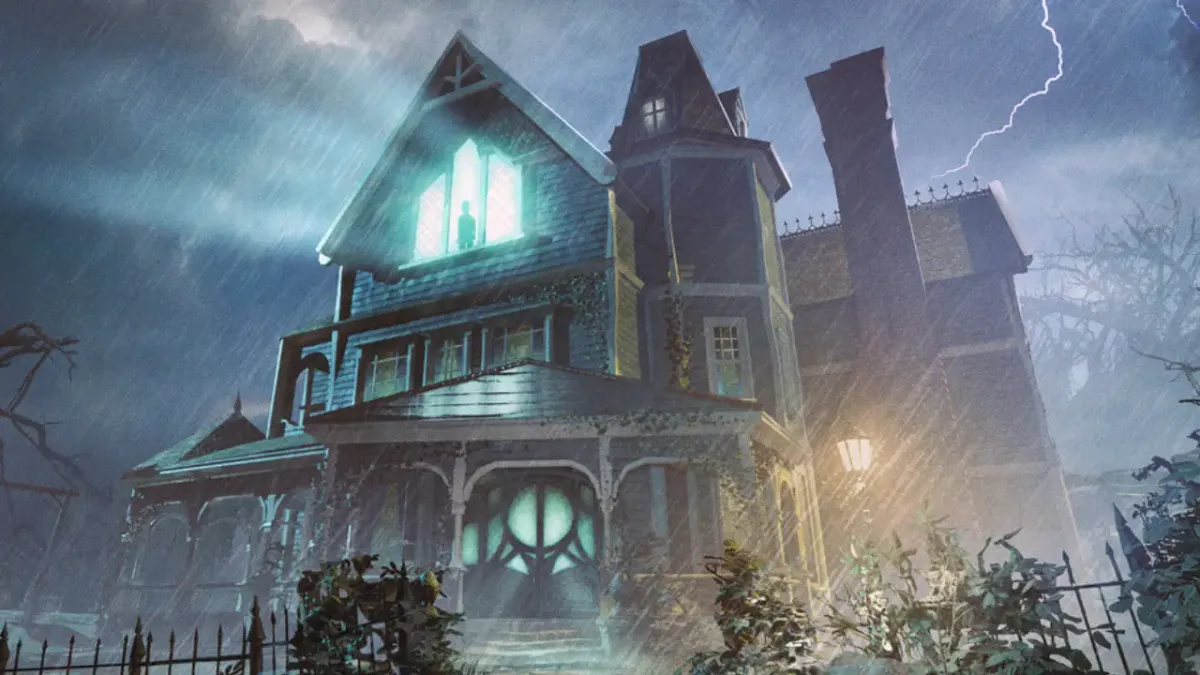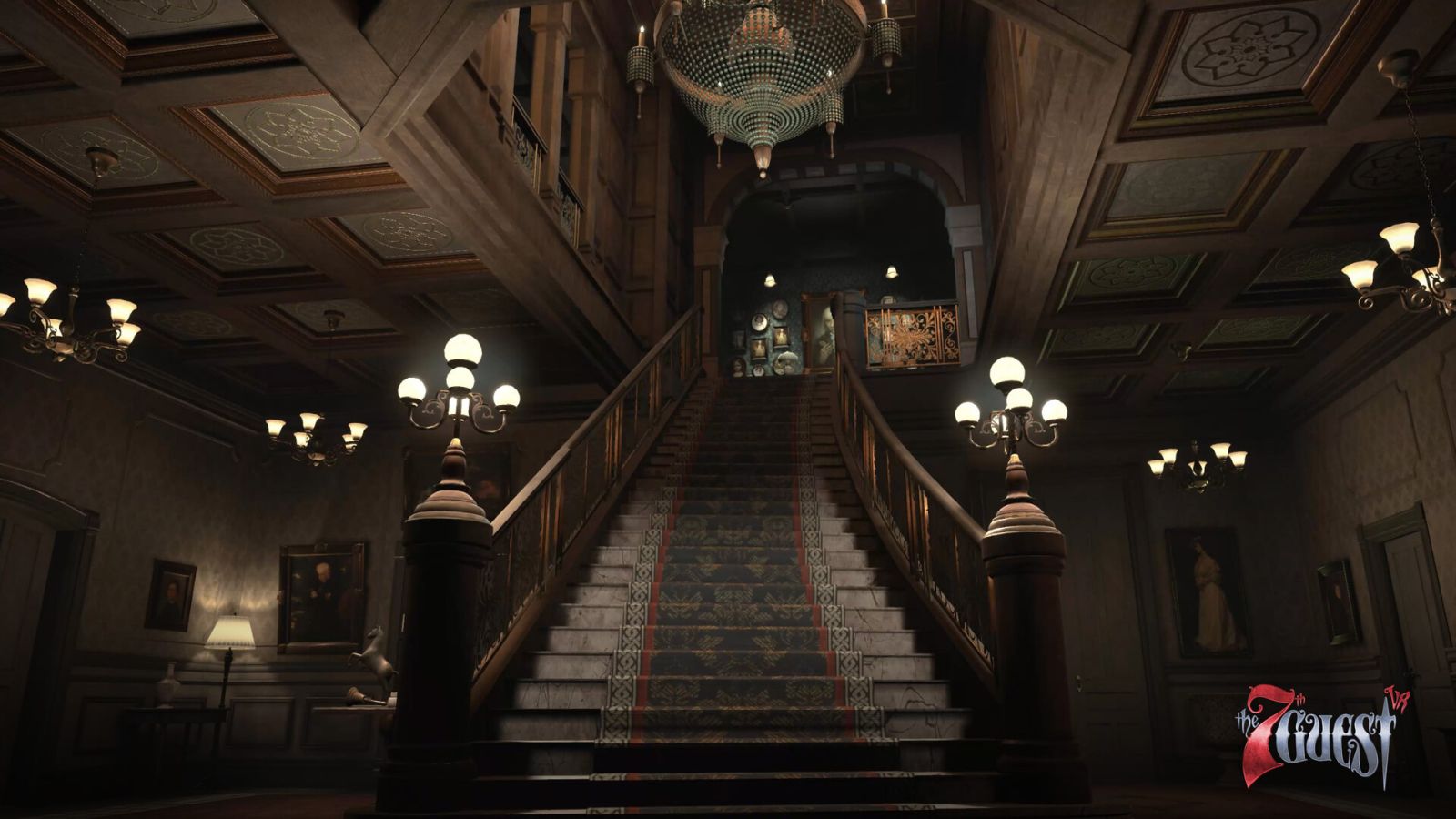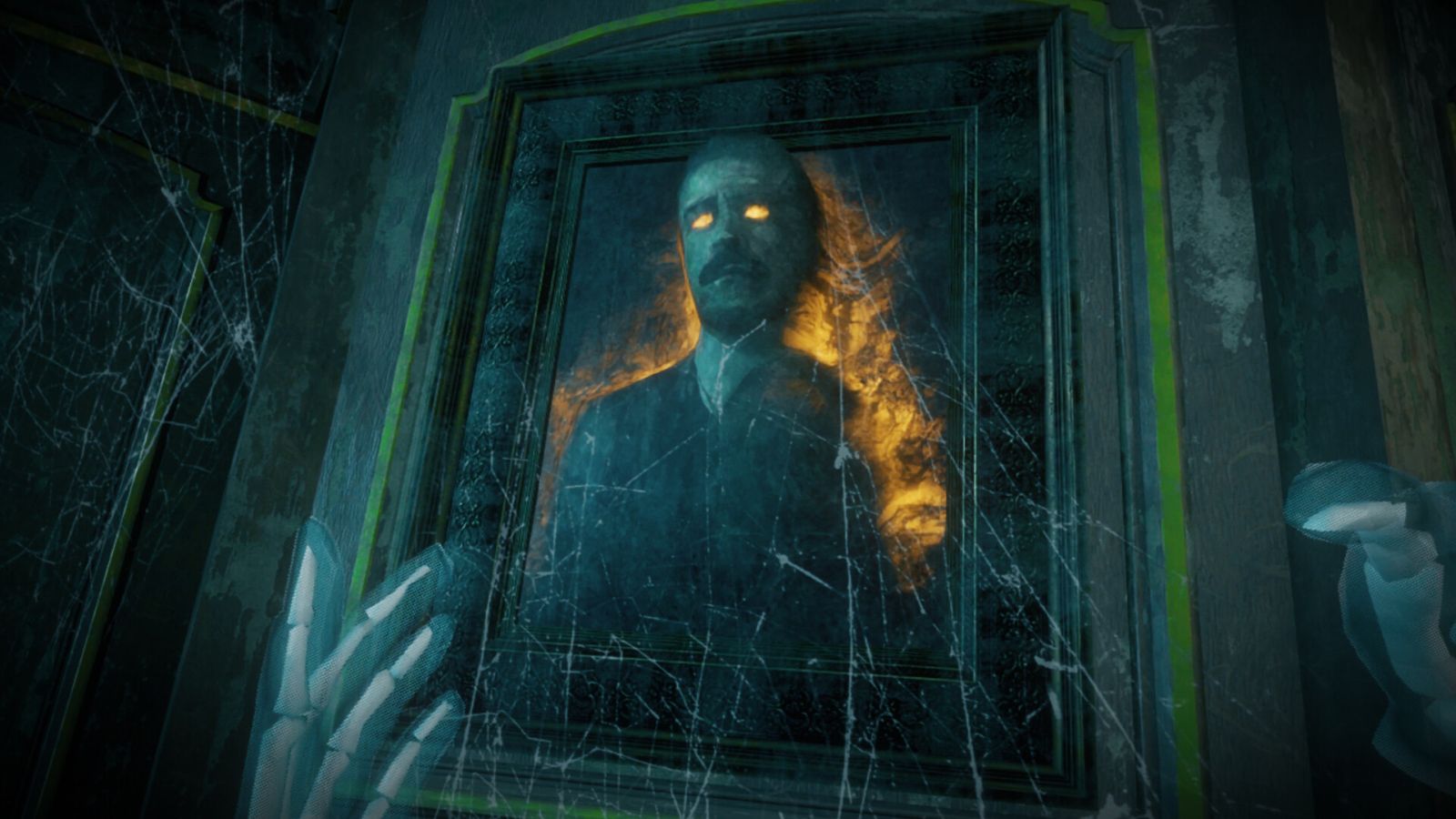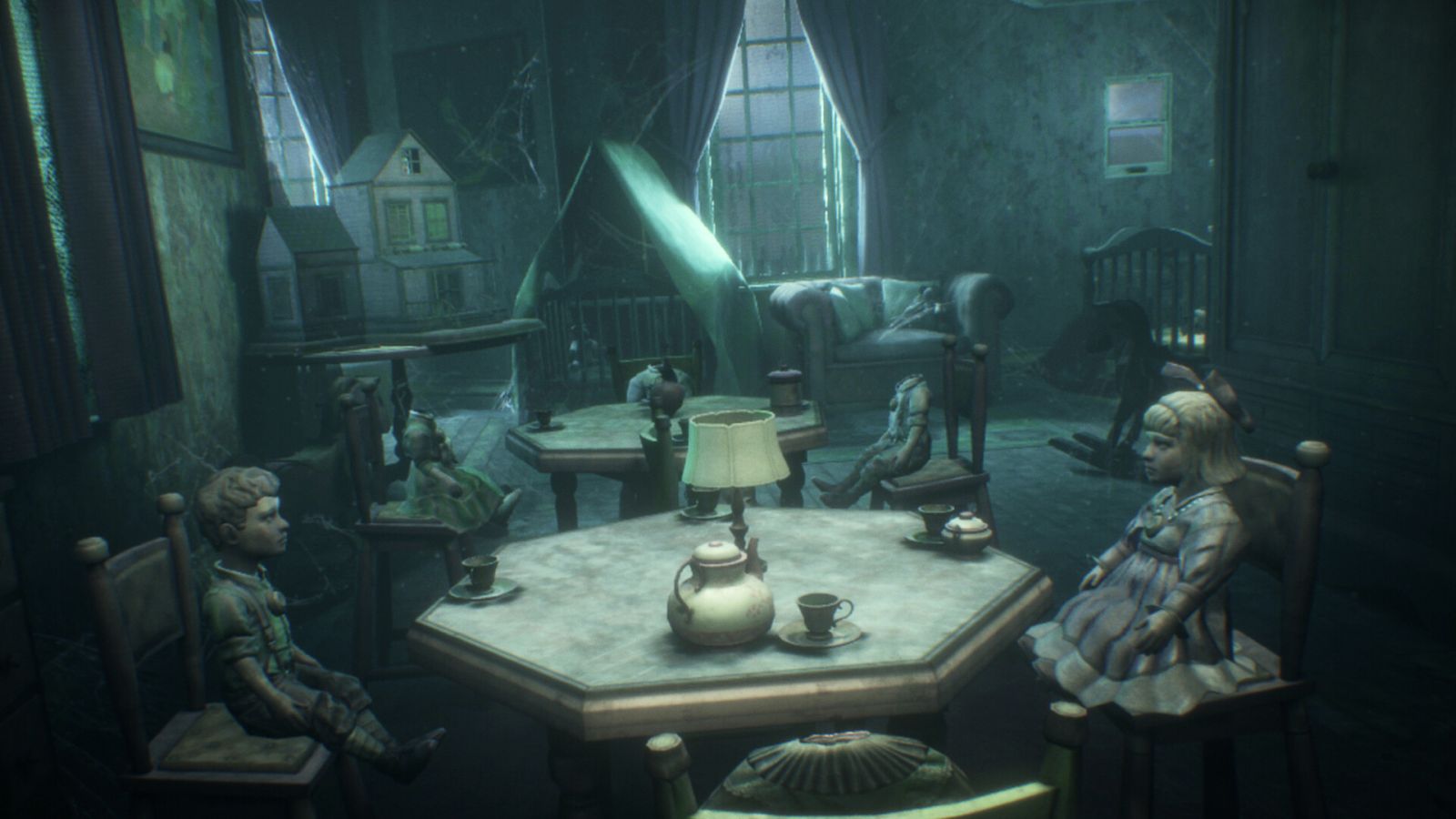
When the 7th Guest debuted in 1991, it represented a completely new world of interactive storytelling. Using a revolutionary medium of CD-ROM, the story was told via six real-world actors projected into the game using cutout methods on top of pre-rendered 3D environments. It was revolutionary at the time. Now, developer Vertigo Games is bringing back this incredible supernatural murder mystery, and with the technology behind it, might just represent a new dawn for virtual storytelling all over again. Welcome once more to the world of The 7th Guest, only this time you’ll be part of the story in a way never before possible.
The 7th Guest VR is a linear game, so any description of the puzzles or settings will reveal some portion of the solutions. As such, I’m going to be a very light touch where possible, but I will talk through the first puzzle room. It’s a fairly easy one, so it won’t stumble you anyway. Anything beyond that will be vague enough to not spoil anything. It’s as spoiler-free of a review as I can muster.
The 7th Guest VR is brought to life by the team at Vertigo Games, but I’d be remiss if I didn’t say it was an equal partnership with the crew at Arcturus. The original 7th Guest game only had to contend with the player on a single visual plane – facing the actors. They did whatever they were going to do in the scene, and the player moved around the space in pre-defined spots similar to games like Riven and Myst. In this new re-telling, the player can move around the space in VR, able to see, interact, and otherwise engage with the world at every possible angle. The fundamental problem, of course, is that it also means you have to capture the actors at every single vantage point, so that’s precisely what Arcturus did.
Pioneering their own volumetric capture technology, the team would digest every square inch of the space, not unlike what the VFX team did with the bullet time effect for The Matrix, only far more smooth. The problem is simple – the player needs to be able to move around the actor within the VR space. The solution, on the other hand, isn’t. It also generates a ton of data. Since this data then has to be loaded into the game, even on an entirely standalone headset like the Meta Quest 2 and 3, the team at Arcturus set about creating a completely new compression algorithm that would keep these omni-angled video files lightweight, even when there are multiple actors on screen. The effect is nothing short of spectacular, bringing the actors into the virtual world with only the smallest amount of occasional angled edges appearing momentarily. The actors themselves are able to then act within the space, and interact with each other, in a way that is completely seamless with the 3D environments that Vertigo Games have built. It’s something you have to see to understand, so let’s do exactly that.
As you can see, six guests have been invited to the mansion of Henry Stauf. Stauf, a reclusive toymaker, has promised each of them something they need, but somehow they’ve all ended up dead. What happened here? How did they die? Who is the titular 7th guest, and how are they important to the tale? You’ll need to investigate each of their stories, solve their mysteries, and unearth the dark secrets underneath the surface.
First and foremost, I loved the characters Vertigo Games has reimagined for The 7th Guest VR. Returning favorites like Martine Burden, Brian Dutton, Edward & Elinor Knox, and others give hammy and over the top performances while somehow keeping it just believable enough to not become silly. It preserves the atmosphere of being slightly campy, but doesn’t undermine that you’ll be encountering some truly nightmare-inducing scenarios that only get worse the more you think about them. Coupled with a fantastic soundtrack (a huge update from the midi-powered original!), the game is a real presentation showcase.
The 7th Guest VR is essentially a series of escape room puzzles. Each is contained to their room, with the central hub foyer acting as a space to provide exposition and atmosphere. As the clock strikes the top of each hour, more rooms become available, and with them, more dark secrets to uncover. I don’t want to ruin too many of them, so we’ll just touch on the very first one – the dining room.
Entering a dusty dining room, an imposing cake topper with a number of symbols on it lies dead center on a huge dining room table. Decorative plates dot the room, nestled above the fireplace. Using our lantern we are able to see into either the past or the future, it’s not immediately clear, revealing the segment under the light as the clean space version it could be. It also restores objects to a repaired state, as well as revealing things that are otherwise hidden.
A quick search of the large table reveals a plate that looks very different than the others. With no idea where to use it, I drop it back on the table and start looking at the walls. It’s here that things really start to take a turn for the bizarre. Looking at the pictures, they appear to be famous works of art. Shining the lantern on them reveals their darker side. Like the paintings at Disney theme parks, each of them has more to reveal. While a few repeat, you’ll find many that you’ve seen before…but not like this.
Further exploring the room reveals a plate display with two empty spots. Grabbing the plate from the table and dropping it into position causes the assembly to slide into place with a satisfying click. We’d need one more plate to solve this puzzle.

Nearby I found some sort of heat register that has a lever sliding puzzle embedded in the surface. You can watch my video if you need the solution, but half the fun is the struggle — I leave that choice to you. Solved, it reveals the third plate. It too slides down and clicks into place, unlocking the cabinet above. Here we’d find a metal tile with a symbol on it, and I knew precisely where to put it.
Heading back to the ornate cake topper in the center we see four symbols repeating all over the device. Turning it we see them over and over — fish, chicken, donkey, person, fish, chicken, donkey, person, fish, chicken, donkey, person. Pressing one lights it up, and pressing the next in the unknown sequence lights it as well, if it’s correct, or resets the trio if it’s not. A bit of deduction, and the replacement of the missing tile, solves the puzzle with a bit of effort. It opens with a loud click as we hit the central button on top, revealing a far more sinister implication underneath. A green cake covered with skulls, crossbones, and what appears to be poison bottles.
With the cake revealed, we see the assembled six guests begin to materialize in the room, talking about how they were all invited here, and that Stauf seems to somehow know each of them. The room, now restored to pristine condition, is complete — we’ve learned all we can here, and the clock now strikes the next hour. More mysteries await.

The original 7th Guest game was told on a flat 2D plane with 3D actors projected onto it. As such, solving the puzzles was more akin to what you’d find in a casual phone game. That’s not a diss against the original – it still holds up, but it was also limited by the technology of its time. None of these puzzles would work in a VR environment. While I appreciate the fantastic puzzles original developer Trilobyte put together, they’ve got nothing on the awesome head scratchers Vertigo Games has in store for us.
I can’t grade the puzzles in terms of difficulty because it very much depends on the way you think. If you are a math oriented person, you’ll have no problem with some of the numerical deduction puzzles. If you are a spatial reasoning person, you’ll be able to solve the challenges that utilize complex logical reasoning more easily. Some of the puzzles are about hunting the space for things hidden from view, and others ask you to understand a particular element, like how the queen moves on a chess board. None of them are impossible, and even if you have to grind out the solution without understanding the particulars, it can be done. If you get unreasonably stuck, however, there’s always coins.

Hidden throughout the mansion are coins. These are the currency you can trade to get a prompt from the game on how to proceed. The puzzle clue is most often enough to solve it, but you can also spend a second one to complete it. I didn’t realize that the second coin would auto-complete the puzzle, not push it forward a single step. As such, there is a puzzle early on in the game that I was unsure how to activate that, to be frank, I’m still unsure how to solve. The game happily accepted my second coin and skipped me past the solution entirely. I won’t get an achievement without re-completing the game, which is a bummer. A warning that you are about to skip a puzzle, and thus disabling an achievement might be in order.
On the flip side of the automatically solved puzzle lies the other side of the coin – NPCs that are far too eager to help. During one puzzle I had to use some Sudoku style reasoning to place some objects in such a way that they add up to a specific number. While manipulating the puzzle and sussing out the solution I was constantly hounded by the NPC for this room, first advising that I could place the objects I was already placing. Next, as I moved them around I was immediately told “Hey, it looks like these add up to a specific number”. Yes – I found that out using my lantern already. This was then followed by another reminder with the specific number mentioned. Listen – I appreciate a good hint, but a toggle to turn these off entirely would be GREATLY appreciated. Let me solve the mystery for myself.

We only encountered one puzzle that came across as completely illogical. During a sequence you have to effectively make a music box that causes an object to move across a space and accomplish a task. Placing pins in the music drum causes an outcome when a large button is pressed. It seems like there are several solutions that would work, but despite inputting a few that followed standard logic and motion, they operated differently than expected. I’m being purposely vague, but this one puzzle frustrated my wife and I for quite some time before we stumbled into the one approved solution. The only other puzzle that was initially confusing is the very last one in which the rules are not explained on purpose, instead learned through pain and loss. I’ll say no more on that one, but it’s a very fun puzzle once you figure it out.
There are a few hiccups that can be solved with a patch. Sitting and standing settings both feel slightly too short or too tall, respectively. There isn’t a height calibration option, so I found myself bouncing back and forth between them on occasion to find the right height. We thankfully only encountered one other bug, this time in the second to last room. There is a simple sliding block puzzle where you have to move objects around a box to unlock it. Unfortunately one of the blocks to become irrevocably stuck, requiring that we pop back to the main menu to reset it.

I’m very happy to report that the entire experience is nausea free. You move relatively slowly through the environment, and there are teleportation and snap turn options in addition to smooth motion choices. As a frequent nausea sufferer, I was able to use the free movement option through the entire (ironically) 7 hour runtime without a single problem.
The price of the 7th Guest VR is just $29.99, which is a surprise given that it is easily one of the best puzzle games I’ve played in a very long time. It pays homage to the original, while updating it for the modern audience. The puzzles all tie together with a tight narrative that had me guessing whodunit all the way till the end. There’s a lot to enjoy here, and frankly it’s one that I’ll gladly revisit when my mushy brain has forgotten the puzzles enough to enjoy it once more. It’s also a great way to introduce new players to the medium as the social screen can let everyone join in the deduction.
The 7th Guest VR
Excellent
Excellent presentation, impressive volumetric technology, head-scratchingly fun puzzles, and a tight storyline come together with engaging VR interactivity to resurrect and reimagine a beloved murder mystery. This game is a must-have for anyone who loves a well-crafted puzzle game.
Pros
- Interwoven and suspenseful mystery storyline
- Volumetric storytelling is a true game changer
- VR interactions are king
- Solid presentation throughout
- Puzzles are a blast
Cons
- Need to be able to disable excessive hints
- Coin system skips puzzles entirely
- One puzzle that required a reset
